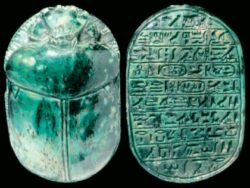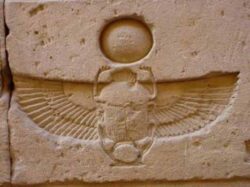
This coleoptera (scarabeus sacer), quite common in Egypt, had an extraordinary fortune.
Truth to tell it’s not exactly know why this insect became the symbol of the becoming and the being but, as it was the Egyptian name for the scarabs Kheprer was phonetic close to the world Kheper, which means “to become”, probably the similar sound of the two worlds induced to chose the scarabs as the hyeroglyphic definite of the “becoming” .
Scarabss which serves as amulets and a box with the shape of a scarabs found in Tarkhan and in Abido reveal that, from the beginning of the tinita period the insect had its symbolic and sacred character who generated himself and was assimilated to Ra, was owed to the theological speclation by the priests in Eliopoli.
Khepri is the sun at sunsut, or better at dawn (he appears under these two forms in the texts in the Pyramids, but he will soon remain, as it’s logic, the arising sun).
The making of the scarabss in different stones or in enamel clay know a great fortune.
The scarabs became, for the living, an amulet that could transmit to them the vital breath it had for magic virtues and there wasn’t any mummy who didn’t wear one on his chest because it avoived that the dead person’s heart could testify against him.
Anyway even other scarabss often accompanied the mummies, already in his own time Mariette had stated that the mummies of the XII dynasty wore it on a finger of their left hand.
The funeral scarabss called “of heart”, had the dead person’s invocation addressed exactly to the heart or prayers to the genes that he believed kept the dead person’s heart, insciptions from the XXVIII and XXX chapters of the book of the dead.

The scarabss can also be on seals on which sentences or functionaries’ titles were engraved, and the Hyksos epoch has left a great number of them with the names of the heads of the Semitic tribes, as Giacobbe or of small sovereigns who surrounded their own name with a cartouche.
These scarabss were decorated with motifs of asian origins: spirals, volutes, interlacements, flowers.
Those decorated with figures make anyway a very rich series in which the decorations surround with their signs, scenes in which the protagonists are kings, gods, animals. Moreover Amenhotep III made a serie of scarabss that commemorated some important historical events.
During the first ten years of his reign, the scarabss celebrated his undertakings as a hunter, and to the second year of his reign goes back a hunt, seven days long that had the honor of being celebrated by many scarabss, in which seventyfive wild animals were killed.
Other series of scarabss commemorate the pharaoh’s marriage with Tiye and Kilukhepa and others were coined to indicate the borders of his empire and to celebrate preparation of a pleasant little lake in his palace.